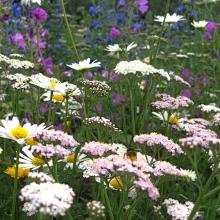
Despite last year's poor summer and this year's long winter and wet spring having contributed to calamitous collapses in Britain's bee population, St Mark's Park is fair humming at the moment.
Over the last 7 days, Spurtle has observed 4 species here: Red-tailed (Bombus lapidarius), Buff-tailed (Bombus terrestris), White-tailed (Bombus lucorum) and Common carder (Bombus pascuorum).
That's more than we've ever noticed in the whole of Broughton before.
The explanation lies in a narrow experimental strip, unmown since last year, which was specially sown in 2012 as part of the Insect Pollinators Initiative.
This is being run to test how introducing a range of wild plant species encourages insect diversity across Britain's urban centres. Another strip is being tested in Pilrig Park, where a slightly shadier spot (see below) seems to have promoted height and delayed flowering, and is consequently a little less jumping with six-legged life for the time being.
Spurtle covered the experiment's start last summer in Breaking news (1.6.12).
Whilst all the bee species spotted so far are native to Scotland, this does not apply to all the wildflower species on which they are cheerfully gorging. Some are, for example, more at home basking on the South Downs.
Does this matter? Not in the short term, certainly, but perhaps so in the long term if more expansive wildflower meadows are to have a non-experimental future as enduring, popular (and highly cost-effective) additions to Edinburgh's public parkscapes.
Judging by the buzz in St Mark's Park, and the looks of genuine pleasure on the faces of passers-by, Spurtle has no hesitation in urging CEC Parks to spend less on the lawn-mowing and more on the Ox-eye, Mallow, Viper's-bugloss and Yarrow.